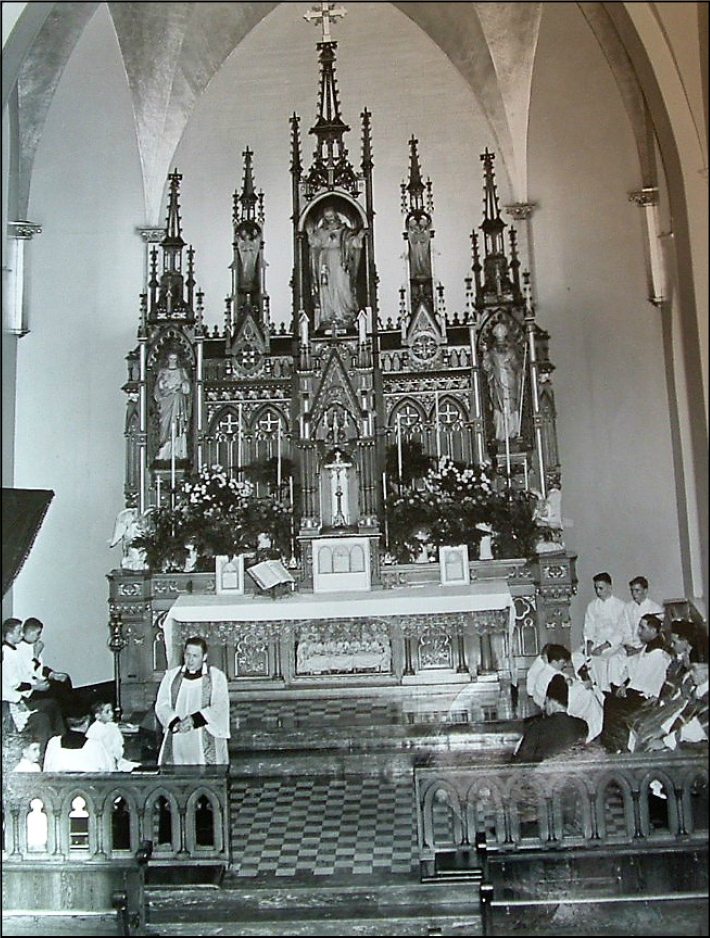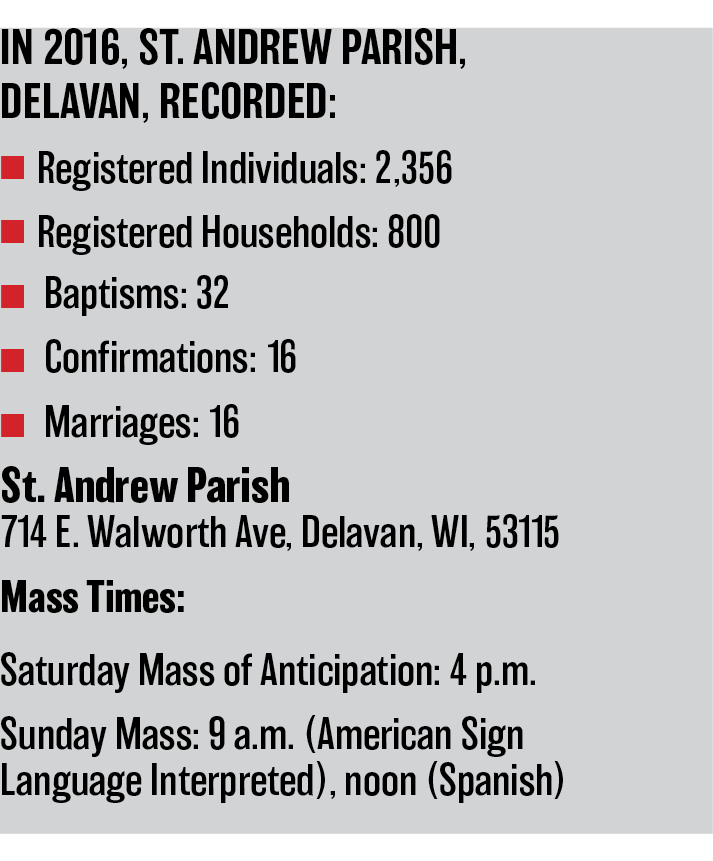
Above: The entrance to St. Andrew, Delavan. Top: A stained-glass window honors the parish’s namesake. (Photos by Tom Andrews)
It’s a church community deeply committed to serving families. It’s also a church with a rich history of serving people from diverse backgrounds with very different needs. As proclaimed in its Mission Statement, “St. Andrew is a multi-cultural family, proud and grateful for its special ministries with the Spanish-speaking, the Deaf and seasonal visitors.”
Welcome to St. Andrew Parish in Delavan.
The people of this parish can trace their church heritage all the way back to 1848. It was a time of pioneering adventure, danger and intrigue as the early settlers were making their way westward.
Only 12 years earlier, the U.S. government had moved Indian tribes west and organized the Territory of Wisconsin. The expanse between Lake Michigan and the Mississippi River was mostly a vast wilderness dotted by a few scattered settlements near the lakes and rivers. Among the earliest settlers were many Catholic families, mostly immigrants from Germany and Ireland.
This was the scene to which a priest named Fr. Kundig was sent in 1841 with a mission to organize parishes wherever there were enough Catholics to support a church. In December 1842, Fr. Kundig penned a letter to his friend Fr. Henni in Cincinnati, explaining that “Up to date, I have organized 20 parishes in and round Milwaukee,” adding that, “Some of these I could only visit quarterly, the others monthly.”
In 1848, Fr. Kundig determined that Delavan was indeed ready and he organized St. Andrew Parish. Soon, it was served by a pair of resident priests from Lake Geneva, Fathers Kernan and Fander. Fr. P.J. Fander offered the very first Mass in 1851 in the home of Francis and Ann Delaney. There was no church building until 1856 when a 32-by-40-foot structure costing $750 was erected for about 50 members at the corner of South Fourth and Matthew streets. Three years later, in 1859, Fr. G. H. Brennan became the full-time pastor. There were no pews until 1862.
As the steady stream of settlers continued to pour into the area, it became obvious that more room was needed. The church was expanded and improved in 1867 at a cost of $2,500 and, on Thanksgiving Day 1871, 300 people were confirmed. As church membership continued to grow, a new church became necessary. In 1892, a large lot at the southeast corner of Seventh Street and Walworth Avenue was purchased. Though there was some opposition to this new site, the cornerstone of the present day church was laid on July 7, 1895.
The new location would prove to be vital for the church in the years ahead. St. Andrew today has the largest church membership in Delavan, serving more than 1,000 families.
“St. Andrew is in the absolute center geographic location in Delavan at the intersection of highways 50 and 11, so this church campus has always been in the center of town,” said Tim O’Neill, a third-generation parishioner who also happens to be Delavan’s police chief. “When the parish decided to build at the intersection of (what became) two state highways, there was some thought as to why that location was good. When you drive into Delavan, you see St. Andrew’s church steeple. I think it’s been a pillar of the community.”

The cornerstone for the current location of St. Andrew Parish was laid in 1895. (Submitted photo)
O’Neill likes to say he’s a “lifer” at St. Andrew, where his family has a long-standing membership and stake in what happens here.
“My dad was a parishioner his entire life and my grandfather was a parishioner for most of his adult life,” said O’Neill. “My family owned the Walgreen’s drug store here in town and two Irish Catholics, Murphy and O’Neill, ran it for 50 years.”
The first Mass at the new St. Andrew Church was offered in the basement on Thanksgiving Day 1895. A year later, a matching rectory was built at a cost of $5,000, using the same Waukesha stone and gothic architecture as the church. Fr. Buckley, who served as pastor for 21 years, arrived as the upper church was completed and on July 12, 1899, the $20,000 church was declared debt free. The sanctuary’s St. Andrew window was donated by Father Smith and gas lights lit the church, to be replaced later by electrical fixtures.
As the church membership continued to grow, the need for more formal religious education for the children of parishioners also became apparent. In 1939, the Sisters of St. Francis arrived and in 1941 a kindergarten was started in the sisters’ home at 119 S. Seventh St., where the school gymnasium now stands.
First-grade classes began the following year and a new class was added each year thereafter.
The current St. Andrew’s School was built in 1948 during the 27-year pastorate of Msgr. McDermott with an auditorium added in 1956.
Jeanne Smiley knows how important this school was when she and her husband came to Delavan in 1952. Her husband was a doctor looking for a place to practice.

“When we first came here, we were starting our family,” said Smiley, who raised 10 children. “I grew up in a Catholic parish with a Catholic school in Milwaukee, and I wanted my children to have that kind of experience. The nuns were teaching all of the grades and they gave our kids the spiritual education they needed. Fr. McDermott was here at that time and he was an absolutely fabulous man. He really impressed me with this dedication and love.”
Dedication and love. These are two qualities that Fr. Oriol Regales is always trying to instill into members of his church family. Fr. Regales, who was installed by Bishop James Schuerman as a shared pastor at St. Andrew on Jan. 14, has also been serving as pastor of nearby St. Patrick Parish in Elkhorn since 2011.
“I’m very excited and I’ve been thinking about that for many months,” said Fr. Regales. “There are many challenges and being the pastor of two parishes is something new in my ministry, but I’m looking forward to encouraging members in both parishes, to serve both parishes and (help them to) become amazing parishes. My goal is not to merge these two wonderful parishes, St. Andrew and St. Patrick’s. My goal is to help them work together, to serve them and help them become two amazing parishes.”
